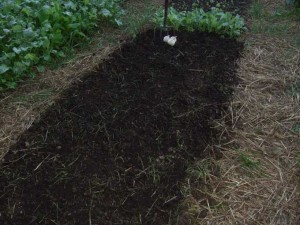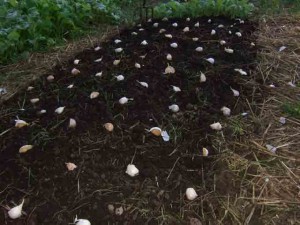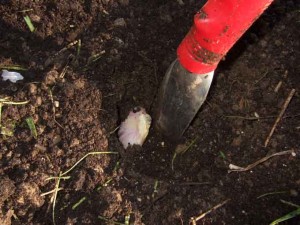I finally found time to plant my gourmet garlic seed a week ago just before the weather turned noticeably colder and killing frosts descended onto the vegetable garden.
The gourmet garlic varieties planted out included Music, German White, Ukrainian Red, and Italian Purple. Over a hundred cloves went into a section of the garden measuring about 15 feet long by 4 feet wide. A dozen potato onion bulbs were planted alongside the garlic in the end of the bed.
Preparing the Garden for Planting Garlic Seed
 The garlic bed occupies the same area that played host to my heirloom tomatoes during the heat of summer. After the tomato plants were removed I planted a quick cover crop of rye that grew to four inches tall before it was turned under to make way for the garlic to be planted.
The garlic bed occupies the same area that played host to my heirloom tomatoes during the heat of summer. After the tomato plants were removed I planted a quick cover crop of rye that grew to four inches tall before it was turned under to make way for the garlic to be planted.
I usually don’t bother planting a cover crop between the summer veggies and the fall garlic but decided to put the raised beds brief down time to productive use this fall. After turning and allowing the cover crop to decompose a bit, the soil in bed was loosened to a depth of about eight inches with a digging fork.
The area was also enriched with the addition of an inch or so of compost that was scratched into the top layer of soil prior to planting the garlic cloves. Late September to early October is the proper time to set out fall planted garlic here in my growing region.
The objective is to get substantial root growth but little or no leaf growth from the garlic cloves before winter sends the plants into hibernation. So how will you know that your garlic seed has germinated if there’s no sign of growth above ground? You won’t, but garlic seed germinates pretty reliably, so just relax and have faith that those roots are growing and preparing the plants for an explosion of green leafy growth as soon as spring arrives!
Sowing Gourmet Garlic Seed in the Backyard Garden
 Garlic grows extremely well in raised beds with an intensive spacing pattern. Rather than planting the seeds in traditional rows, I use
Garlic grows extremely well in raised beds with an intensive spacing pattern. Rather than planting the seeds in traditional rows, I use
a grid like pattern that spaces the plants an equal distance apart in each direction. The garlic seed is planted far enough apart so that the plants are separated by a distance of six to eight inches.
An easy way to eyeball your garlic spacing is to lay out all of the separated seed cloves on top of the ground so that you can space them evenly. Once the seeds are positioned it’s a snap to go back and plant the cloves without worrying where you left off, or where you have already planted seed.
The cloves should be set one to two inches deep. I use a trowel to pry open a planting slit that is then half filled with an amendment of compost, worm castings, and a little bone meal. The garlic seed clove is then gently pressed down into the welcoming soil, pointed end up of course.
It Doesn’t Get Any Easier than Growing Garlic in the Garden
 Fill in the hole and the hardest parts of growing garlic are behind you because this is such an easy and rewarding crop to grow in the home garden. A thick mulch of shredded leaves or straw will be applied after the ground begins to freeze to protect the plants over the winter and prevent weed growth next spring when the plants send up leaf growth.
Fill in the hole and the hardest parts of growing garlic are behind you because this is such an easy and rewarding crop to grow in the home garden. A thick mulch of shredded leaves or straw will be applied after the ground begins to freeze to protect the plants over the winter and prevent weed growth next spring when the plants send up leaf growth.
Of course you could wait and plant your garlic seed next spring but then you lose out on the advantage that fall rooted garlic plants provide in late winter when they are all ready to start growing. Some varieties are also thought to develop superior flavors after being exposed to a harsh, cold winter in the ground.
I’ve yet to see a garlic bed attacked by any type of insect and my biggest problem with wildlife has come from rabbits. They don’t eat the plants but can become a pest as they run through the beds toppling the plants as they go. Battling the bunnies is a small price to pay for the large and delicious homegrown garlic bulbs harvested in mid summer from fall planted seed.



10 Responses
I planted my garlic last Friday. I bought from a place you recommended on your blog earlier this summer. Can’t wait for super tasty homegrown garlic next year!
There have been a half-dozen or more garlic-planting posts on the Blotanical lists recently, but this one is by far the most thorough. Thank you!
I do have a question: you appear to be planting whole bulbs, while Compostings says to break the bulb up and plant individual cloves. ???
I tried to “pick” this post at Blotanical, but it’s not showing properly. I left a message about this at your plot–
–Kate
Susy, if you like garlic I think that you will be very pleased with the differences between store bought garlic and what will be harvested out of your garden. There is just such a big range of flavors and levels of spiciness.
Hi Kate, thanks for stopping by and sharing this over at Botanical. I do separate the garlic bulbs into individual cloves before planting.
Ah. Thanks for clarifying. Fluffius Muppitus says that if you plant several cloves close together you can pull them early as spring garlic. Have you ever heard of that?
–Kate
I had such a good crop of Fireball garlic last year, that I used some of the best cloves for planting last week. Hope that works. Have others saved their own bulbs or are you buying new ones every year?
Kate, yes you can space your garlic seed much closer together if your intention is to harvest spring or baby garlic. Sometimes I’ll plant a section of garlic with just that in mind. Also if you miss digging up any of the previous season’s garlic harvest the whole bulbs that were left in the ground will send up clumps of baby garlic that can be treated as spring garlic or a companion plant for the garden.
Hi Cynthia, I usually save save some of my own garlic bulbs for seed provided the crop was productive, healthy, and there is no sign of disease. Garlic is a breeze to produce your own seed and there is no worry of different varieties crossing. I also use the biggest and best looking bulbs as my seed stock. But I still often wind up buying some garlic seed just to try out new garlic varieties that I don’t have.
Spittlebugs are one of the few insects I’ve seen on garlic, but they take to it eagerly.
Some issues to be aware of with self-saved seed garlic are nematode multiplication, and viral load increase.
Some microscopic nematodes live in the stems of garlic and multiply through a few generations, then BANG! A whole crop succumbs all at once to nematode infestation.
Viri continue to multiply in bulbs for generation after generation and cause the stock to become progressively weaker. One non-technical way to check for virus infection is to check the leaves of your garlic plants for yellow streaks. You won’t know which virus it is, but you can be fairly sure the garlic is being weakened by a virus. Go ahead and eat those garlics, the virus won’t hurt you, but don’t replant them.
Buy new seed stock from suppliers that understand these issues and you’ll be enjoying your delicious garlic every year!
Some issues to be aware of with self-saved seed garlic are nematode multiplication, and viral load increase.
Some microscopic nematodes live in the stems of garlic and multiply through a few generations, then BANG! A whole crop succumbs all at once to nematode infestation.
Viri continue to multiply in bulbs for generation after generation and cause the stock to become progressively weaker. One non-technical way to check for virus infection is to check the leaves of your garlic plants for yellow streaks. You won’t know which virus it is, but you can be fairly sure the garlic is being weakened by a virus. Go ahead and eat those garlics, the virus won’t hurt you, but don’t replant them.
Buy new seed stock from suppliers that understand these issues and you’ll be enjoying your delicious garlic every year!